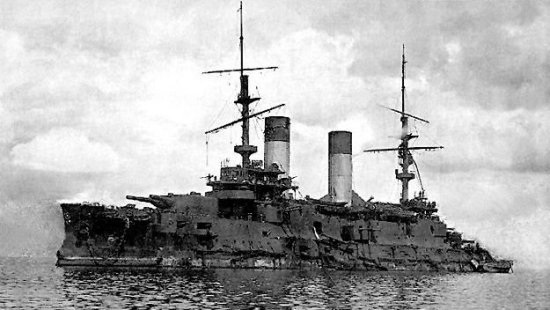
The Russo-Japanese War was fought over dominance over Korea and Manchuria and concentrated on Port Arthur (now Lüshun).
The Japanese had taken that port in early 1905 CE and had also destroyed the Russian Far East fleet.
Still they were not sure of victory, as the Russian Second Pacific Squadron, made up of the larger part of the Baltic Fleet,
sailed half the world to relieve their fellow marines in the east, a stark feat.
The journey was long and exhausting to both ships and crew, therefore they aimed to anchor at Vladivostok first for maintenance.
Three straits were available to reach that port: La Perouse, Tsugaru and Tsushima, the shortest one.
The Russian admiral Rozhestvensky chose the latter, but his counterpart Togo was waiting for him with a screen of scouts.
The Russian fleet numbered 8 battleships, 3 coastal defense (battle-)ships, 4 armored cruisers, 4 protected cruisers, 9 destroyers and 12 smaller ships.
Some were modern, others obsolete.
They were fouled from their long voyage, reducing their battle speed to less than 20 kilometers per hour, while the Japanese could maintain nearly 30.
The Japanese had 4 battleships, 1 old battleship, 8 armored cruisers, 15 protected cruisers, 20 destroyers, 16 torpedo boats and 3 dispatch vessels.
Contrary to the enemy, these had all recently been refitted in port.
Their crews had been trained relentlessly by Togo and his officers.
The Russians tried to slip through the strait unnoticed, helped by darkness and fog.
However the lights of the hospital ship Oryol were still on and spotted by a Japanese cruiser, which alerted the fleet.
At daybreak Togo set sail.
For a long time he did not have the Russians in his sights, but his scouts kept him up to date with wireless telegraph messages.
In the early afternoon the Japanese battle line, coming from the north-northeast, descended on the Russian one, coming from the southwest.
The Russians fired the the first shots, at a range of 7 kilometers, unprecedented in naval battles up to that point.
The Japanese fleet returned fire, executed a U-turn in good order and then engaged in full.
The Japanese sailors and gunners were much better trained than the Russian conscripts and used superior range finders.
This enabled them to fire three times faster than the Russians and also more accurately.
The Russians used armor piercing shells, while the Japanese fired "furoshiki", high explosive shells that set paint and coal on fire.
As the long voyage had forced the Russians to store much coal on deck, this caused many an inferno.
The Japanese used their advantage in speed and maneuverability to engage the enemy ships where their fire was most effective.
The Russians quickly started to lose ships.
Their Oslyabya was the first ever battleship to be sunk by gunfire.
During the day the Russians lost four more of their battleships and also their commander, who was knocked out by enemy fire.
At night they fled north, harried for three hours by attacks from Japanese destroyers and torpedo boats.
There was more gunfire, many torpedo attacks and a few collisions.
Four more Russian battleships were sunk; they rest managed to break away under the darkness.
In the morning the Japanese fleet sighted the Russians again and resumed the attacks.
The new Russian commander Nebogatov signaled surrender, but this was misunderstood by Togo.
Eventually Nebogatov showed defeat by hoisting the Japanese navy flag.
After the battle some Russians ships escaped, though some were captured by the Americans or scuttled by their crews.
As a result the Second Pacific Squadron lost all of its battleships and most of its cruisers and destroyers.
4,400 Russians were killed and 7,800 captured.
The Japanese lost only 3 destroyers and 120 dead plus 500 wounded.
The battle ended the Russo-Japanese War in Japan's favor.
It greatly enhanced the prestige of the Japanese navy, making it overconfident in the following decades,
where it doggedly stuck to the doctrine of the 'decisive battle'.
The combat convinced admirals all around the world of the power of battleships, starting a naval arms race.
War Matrix - Battle of Tsushima
Second Industrial Revolution 1880 CE - 1914 CE, Battles and sieges


